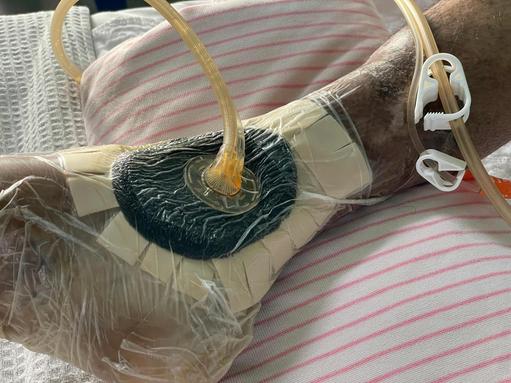- The field of regenerative medicine is experiencing significant advancements and has the potential to transform healthcare by offering novel treatments, repairing damaged tissues and organs, and improving patients' quality of life
- Key technologies shaping its future include stem cell research, tissue engineering, electro-stimulation, gene therapy, organ regeneration, 3D bioprinting, and nanotechnology
- The progress of these technologies varies, raising the question of which will dominate the field in the next decade
- Convergence of these technologies will play a pivotal role in transforming regenerative medicine
- Advantages and challenges exist for each technology, and dominance will depend on scientific breakthroughs, clinical success, regulations, and patient acceptance
- MedTech companies must intensify their R&D efforts in regenerative medicine to remain relevant
- Collaboration between disciplines, institutions, and industry partners is crucial
- Staying informed about emerging trends and breakthroughs is essential
- Proactively identifying synergies and areas of collaboration can accelerate progress
- MedTechs can actively shape the future of regenerative medicine by exploring and integrating evolving technologies
The Future of Regenerative Medicine
Navigating Evolving Technologies and the Imperative for MedTech Companies
In the rapidly evolving realm of modern medicine, regenerative medicine has emerged as a transformative and powerful force. With several innovative developments at its core, it has the potential to change our approach to healing and restoration. The long-awaited promise of personalized, curative, and transformative therapies appears to be within reach, giving hope to patients who have been waiting for breakthroughs.
Over the past decade, this broad field of medicine has witnessed significant developments, with various technologies emerging as promising avenues for medical innovation. Stem cell research, tissue engineering, electro-stimulation, gene therapy, organ regeneration, 3D bioprinting, and nanotechnology have all demonstrated their potential in addressing complex medical conditions. However, these technologies are progressing at different rates, and are often used complementarily, giving rise to a key strategic question for MedTechs investing in regenerative medicine research and development (R&D): Which technology or combination of regenerative medicine technologies will ultimately dominate the field in the next decade?
As this market segment gains momentum, it seems reasonable to suggest that many MedTechs have yet to fully grasp the magnitude and pace of these technological developments. To establish a presence or expand their footprint in this arena, companies must intensify their R&D efforts and monitor developments across the full range of these technologies to ensure they are not caught off guard. Time is of the essence, and those who fail to recognize this, risk being left behind.
Regenerative medicine
Regenerative medicine encompasses a broad range of approaches aimed at repairing, replacing, or regenerating damaged or diseased tissues and organs in the body. It draws upon principles from biology, engineering, and other scientific disciplines to restore both the structure and function of compromised tissues and organs. The concept underlying regenerative medicine involves utilizing the body's innate healing mechanisms to facilitate tissue repair and regeneration. This incorporates various techniques used either independently or together, and include stem cell therapy, tissue engineering, electro-stimulation, gene therapy, organ regeneration, 3D bioprinting, and nanotechnology, which either stimulate the body's natural regenerative processes or provide external support for tissue regeneration.
Brief history
Regenerative medicine has a rich history, driven by humanity's quest to heal and restore damaged tissues and organs. From ancient civilizations to modern times, medical science has continually evolved, seeking solutions to overcome the limitations of conventional treatments. This pursuit has given rise to the field of regenerative medicine. Early healers in ancient civilizations explored various remedies and techniques to promote tissue repair, ranging from herbal medicines to primitive surgical interventions. These practices laid the groundwork for our understanding of the body's inherent regenerative capacity.
In the 20th century, scientific advancements began unlocking new possibilities. The discovery of stem cells in the 1960s marked a breakthrough, revealing a versatile cell population capable of self-renewal and differentiation into specialized cell types. This discovery represented a paradigm shift in medical research and served as the foundation for modern regenerative medicine. The isolation and cultivation of human embryonic stem cells in the early 2000s was a significant milestone, offering potential for regenerative therapies. However, ethical concerns surrounding their use prompted scientists to search for alternative approaches. This led to the discovery of induced pluripotent stem cells (iPSCs) in 2006, which could be derived from adult cells and reprogrammed to resemble embryonic stem cells, thus bypassing the ethical concerns.
In recent years, regenerative medicine has experienced a surge of new and rapidly evolving medical technologies. Tissue engineering, biomaterials, gene editing techniques [a method for making specific changes to the DNA of a cell or organism], and advanced imaging modalities have impacted the field, enabling the creation of 3D tissue constructs, the bioengineering of organs, and direct tissue regeneration within the body. Regenerative medicine has expanded beyond traditional approaches, encompassing a wide range of therapeutic strategies, including cell-based therapies, gene therapies, electro-stimulation, and the utilization of growth factors and biomaterials. This multidisciplinary approach, leveraging the expertise of scientists, bioengineers, and clinicians, aims to develop transformative therapies for previously untreatable conditions.
In this Commentary
This Commentary explores the rapidly evolving technologies that have propelled regenerative medicine to the forefront of medical research and their potential implications for the future of healthcare. We describe the contributions to regenerative medicine of stem cell research, tissue engineering, electro-stimulation, gene therapy, organ regeneration, 3D bio printing, and nanotechnology. The Commentary discusses some of the challenges and ethical considerations facing the field and draws attention to governments actively pursuing regenerative medicine R&D. We stress that technologies, which contribute to this field are progressing at different rates and are often used complementarily. This raises a strategic question for MedTechs investing in regenerative medicine R&D: “Which technology or combination of regenerative technologies will ultimately dominate the field in the next decade?”. Answering this question should provide MedTechs, either contemplating entering this market segment or with established regenerative medicine franchises, with insights to guide their strategic decision-making and to assist in their long-term success in this rapidly evolving field.
Stem cell research
Stem cell research has changed regenerative medicine, opening new possibilities for tissue repair and disease treatment. One significant advancement is the development of Induced Pluripotent Stem Cells (iPSCs). These are created by reprogramming adult cells and can differentiate into any cell type, making them invaluable for personalized therapies. Unlike embryonic stem cells, iPSCs alleviate ethical concerns. However, ethical issues related to human cloning persist (see below). Nonetheless, iPSCs serve as a crucial tool, offering safer and more efficient techniques for studying diseases, screening drugs, and developing personalized therapies. They also enable the replacement of damaged cells and the creation of functional tissues and organs, providing opportunities for organ transplantation and personalized tissue replacement treatments. Researchers have also achieved success in transdifferentiation, rapidly generating desired cell types for regenerative and transplantation therapies. The gene-editing tool CRISPR-Cas9, (see below), further enhances stem cell research by allowing precise modifications for disease correction and improved traits. Clinical trials have demonstrated the potential of stem cell-based therapies in various areas, including spinal cord injuries, neurodegenerative disorders, heart disease, blood disorders, and diabetes. Advancements in bioengineering and microfluidics have further improved stem cell growth and differentiation, bringing us closer to fully harnessing the power of stem cell-based regenerative medicine.
Several companies and research institutions have made contributions to stem cell R&D. Mesoblast, an Australian biopharmaceutical company founded in 2004, focuses on developing cellular medicines based on mesenchymal lineage adult stem cells. They are actively involved in creating regenerative therapies for cardiovascular diseases, orthopedic disorders, and immune-mediated inflammatory diseases. Novartis, a Swiss pharmaceutical company, has made substantial investments in stem cell research and is dedicated to developing treatments for conditions such as macular degeneration and heart failure. Cellular Dynamics International (CDI), a biotech based in Japan and a subsidiary of Fujifilm, specializes in producing human iPSCs for use in drug discovery, toxicity testing, and disease modeling. Athersys, a biotech based in Cleveland, Ohio, US, focuses on developing innovative stem cell-based therapies. Their leading offering, MultiStem®, is a patented, adult-derived stem cell therapy platform designed to treat various disease states, including neurological disorders, cardiovascular diseases, and inflammatory conditions. Athersys has received Fast Track designations from the US Food and Drug Administration (FDA) for acute respiratory distress syndrome (ARDS), stroke, and transplant support. In 2022, Vertex Pharmaceuticals, based in Boston, US, acquired ViaCyte, a US biotech, for US$320m in cash. ViaCyte specializes in delivering novel stem cell-derived cell replacement therapies as a functional cure for type 1 diabetes (T1D). This acquisition provides Vertex with additional human stem cell lines, intellectual property related to stem cell differentiation, and manufacturing facilities for cell-based therapies, which can accelerate the company's T1D programmes. ReNeuron, a UK-based biotech focuses on developing cell-based therapies, for conditions like stroke disability, retinal diseases, and peripheral limb ischemia. Osiris Therapeutics, founded in 1993, developed Grafix®, a cryopreserved placental membrane used for wound healing and tissue repair. In 2019, the company was acquired by Smith & Nephew plc, a global medical technology business, for US$660m.
Tissue Engineering
Tissue engineering is a field that combines biology, engineering, and medicine to create functional tissues and organs. It has made advancements recently, such as the development of organoids used for studying diseases and personalized medicine. Biomaterials, like hydrogels, nanofibers, and 3D-printed scaffolds, play a role by providing support for cell growth. One challenge tissue engineering faces is creating blood vessels to ensure the tissues receive enough nutrients and oxygen. Researchers are using techniques like 3D bioprinting (see below), to create networks of tiny blood vessels within engineered tissues. 3D bioprinting allows for precise placement of cells and materials to create complex tissue structures. Decellularization, which removes cellular components from donor organs and replaces them with patient-specific cells, has also been successful in organ regeneration. Microfluidics and organs-on-a-chip platforms are used to mimic organ functions for studying diseases and testing drugs. Gene editing technologies like CRISPR-Cas9 (see below) show promise for modifying cells, enhancing tissue regeneration, and correcting genetic disorders.
|























